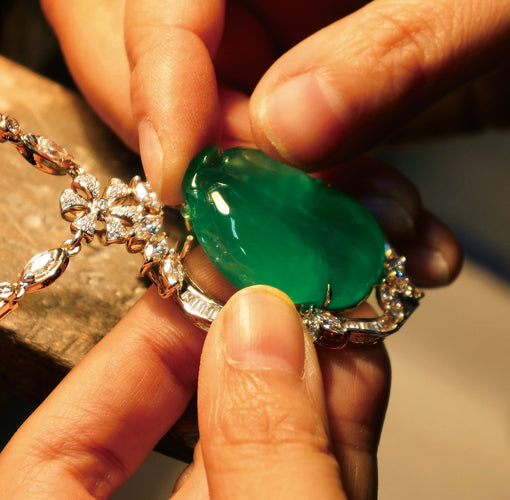What is Jade?
“Jade” is a cultural term used for a very durable material that has been fashioned into tools, sculptures, jewelry, gemstones, and other objects for over 5,000 years. Since 1863, it was discovered that jade could be divided into two different minerals: jadeite and nephrite. Since jadeite and nephrite have very similar physical properties in the eye of an average person, both of them can be correctly called jade.
Jade, known as “Yu” (玉) in China, was historically used in pre-1800 China to decorate axe heads, knives, and other weapons and was preferred because of its toughness. Today, it is considered the most highly regarded gemstone in the Chinese culture.
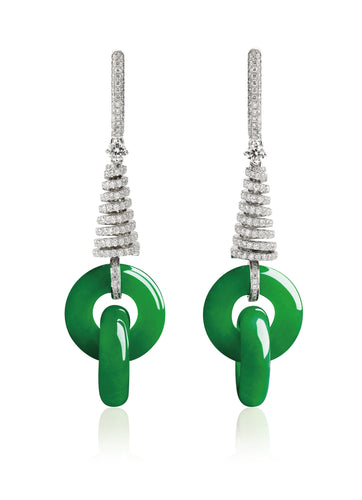
Nephrite comes in a creamy white form and several shades of green, while jadeite boasts a wider range of attractive colours. Nephrite’s colour tends to be more muted than jadeite’s, and they’re often mottled or streaked.
Nephrite are sourced all over the world, including China, Russia, Canada, Turkey, etc. But Jadeite is a lot rarer since it has only been found in Myanmar (Burma). Based on its origin, Nephrite can be further named. The most well known and best quality nephrite is named “Hetian Jade”, since it is mainly produced from the Kunlun and A’erjin Mountains, located in Hetian, Xinjiang in northwestern China. The area is known for yielding the famous top-quality white “motton fat” jade. British Columbia in Canada is another major origin of nephrite. Today there are more than 50 nephrite occurrences adjacent to Fraser River area in southern BC, the Mount Ogden area in central BC, and the Cassiar jade fields in the far north. Nephrite mined in BC are called “BC Jade” and usually have a very obvious green hue, called “green nephrite” (“BI Yu” 碧玉in Chinese). Green nephrite can also be found in Siberia, Russia. Although it entered the China market only about 10-15 years ago, green nephrite from Russia has gained a great reputation because of its bright colour and good transparency. Both white and green nephrite are mined in Russia.
Different from Nephrite’s variety in its kind and origin, jadeite is solely sourced from Myanmar (Burma) and only has one kind and one name – “Fei Cui” (翡翠in Chinese). Considered relatively new in the Chinese market, it was in the 1700’s the first jadeite reached China from Myanmar, displaying incredible colour, transparency and texture. Jadeite can be found in colours such as purple, yellow, reddish orange, white, gray black and brown and many shades of green. The vivid green shade of jadeite was highly regarded among the royal family of the Qing Dynasty and has been given called “Imperial Green”. It is considered the most valuable jadeite colour and can command thousands of dollars.
For decades, jadeite was exclusive to the Chinese royal family as a symbol of royalty, power, and wealth. In the modern days, especially with the rise of China’s economy in the recent 40 years, many more people can afford to purchase Jadeite. Demand is outweighing the annual supply mined and over the past decade, the price of the finest jadeite has increased tenfold to $3000 an ounce, making it far more valuable than gold. Jadeite jewelry is being offered by major auction houses quite regularly fetching higher and higher prices. Next to certain rare colours of diamond (blue, red and pink) Jadeite is the world’s most expensive gem, with prices far above even ruby and sapphire! Of the top ten most expensive jewels sold worldwide by Christie’s in 1999, five out of ten were jadeite, including three of the top four. These auctions clearly show that jadeite is among the most valuable of all gemstones.
The importance of Jade in Chinese culture is reflected in its status as a symbol of goodness, preciousness and beauty. To the Chinese, jade is also the embodiment of the Confucian virtues of courage, wisdom, modesty, justice and compassion. The polish and brilliance of jade is considered by the Chinese to be representative of purity while its compactness and hardness reflect intelligence. Justice is represented by its angles and the sound produced by it when it is struck is a symbol of music. The colour of jade depicts loyalty while its flaws reflect sincerity. The Chinese also value jade because of its brightness; representing heaven, while its substance is representative of the earth.
There is a Chinese saying that goes, "Gold has a value; jade is invaluable". Chinese people love jade not only because of its aesthetic beauty but also because of what it represents regarding social value. The significance of jade to Chinese culture is evident, not only historically, but at present as well. The Chinese term for jade, "yu" (玉) is often used in family names as well as in terms that describe people or things that are beautiful.
Jade in Chinese Culture and History
The importance of Jade in Chinese culture is reflected in its status as a symbol of goodness, preciousness and beauty. To the Chinese, jade is also the embodiment of the Confucian virtues of courage, wisdom, modesty, justice and compassion. The polish and brilliance of jade is considered by the Chinese to be representative of purity while its compactness and hardness reflect intelligence. Justice is represented by its angles and the sound produced by it when it is struck is a symbol of music. The colour of jade depicts loyalty while its flaws reflect sincerity. The Chinese also value jade because of its brightness; representing heaven, while its substance is representative of the earth.
There is a Chinese saying that goes, "Gold has a value; jade is invaluable". Chinese people love jade not only because of its aesthetic beauty but also because of what it represents regarding social value. The significance of jade to Chinese culture is evident, not only historically, but at present as well. The Chinese term for jade, "yu" (玉) is often used in family names as well as in terms that describe people or things that are beautiful.

Jade Carvings
Chinese craftsmen have been carving jade for over 5,000 years. While modern tools have been allowed more complex designs to be made, carving today remains a very painstaking process that requires much patience to create desired design. Jade carvers are highly trained to study each unique stone’s colour, clarity and patterning before creating a design that will utilize the most from the raw stone material and showcase their best features. The jade carving process can take anywhere from twelve to twenty-four hours to finish, depending on the design, while more complex design can take two to four days. Along with the quality of the stone, the carving is also what determines the worth of the jade item.
The Chinese associate jade with clarity of mind and purity of spirit. Some of the ancient symbolic motifs still used in modern jade carvings. For example:
- Bat – good fortune
- Cabbage - wealth
- Peach – long life
- Fish – surplus
- Dragon – power and prosperity
- Toad – money and wealth
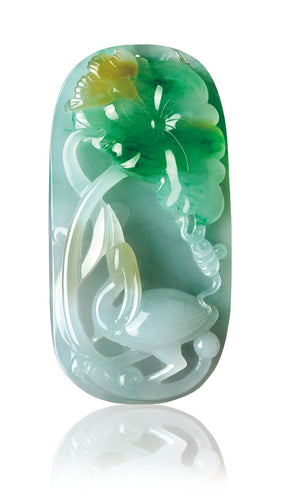
Jade’s Spiritual Side
For thousands of years jade has been cherished for its purity, and endurance. It resonates on a deeper spiritual level in many of the world’s traditions. The wearer believes it could lift them to the highest spiritual aspirations, protect them from harm and disease and also bring to them prosperity, success and good luck.
It is also one of the most important minerals in the practice of feng shui. In feng shui, jade has been used for centuries for its abilities to create a serene feeling of harmony and balance. Jade is also used as for protection and for good luck feng shui stone. You can find endless good luck feng shui charms made of jade, employed for various purposes—from creating wealth to attracting more friends. Jade jewelry is also a popular feng shui application for the body energy, which is no less important than your home feng shui!
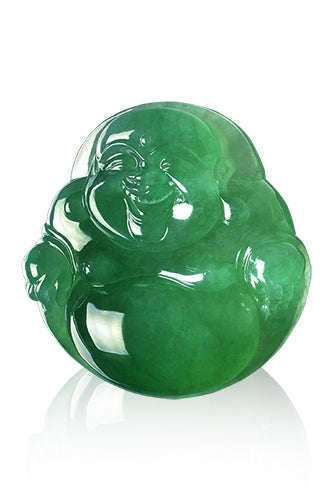
Jade’s Durability & Care
Jade is comprised of metamorphic rocks, made up of tiny interlocking mineral crystals. On the MOHS scale, nephrite is given the hardness of 6.0 to 6.5 and jadeite 6.5 to 7.0. With day-to-day wear, dirt, chemicals, makeup, perspiration and oils from your skin can cause build-up that may cause the surface of the jade to dull. You can wash your jade periodically with a mild soap and rinse in clean water drying with a cotton towel. DO NOT put into an ultrasonic!
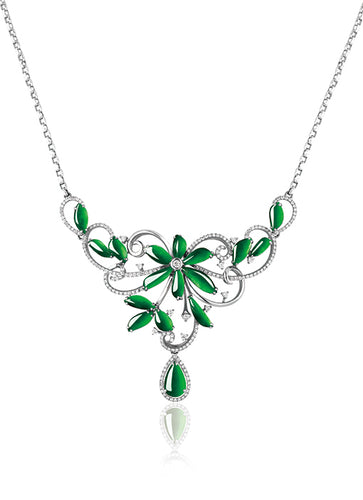
Jade Types and Treatments
There are many ways to improve jade’s appearances. Heat, wax, dye, bleach, acid, polymer injection and other treatments have all been used to improve the colour, luster and stability of jadeite and nephrite. Some of them are considered normal part of traditional jade manufacturing process, while others are not. To differentiate their treatment, jadeite products are placed into three “types”:
- Type A Jadeite – 100% natural and only treated with a coating of wax to give its surface a smooth and lustrous finish. In many certificates, this is the ONLY type that will be described as “natural jadeite” (天然翡翠in Chinese).
- Type B Jadeite – have been bleached by soaking in hydrochloric or sulfuric acid. The acid removes oxidation stains and leaches out sodium. Impregnation fills all surface-reaching pores and fractures and gives the object an improved smoothness, l uster and colour. However, acid treatment makes jadeite brittle and polymer resins can discolour with time or exposed to heat and sunlight. Therefore, Type B jadeite treatment shall always be disclosed in jadeite certification.
- Type C Jadeite – has all treatments of Type B jadeite, plus dye treatment. The dyes can fade over time or with exposure to heat and light. For these reasons, Type C treatment should always be disclosed in jadeite certification.
On today’s market, the price of both Type B and Type C Jadeite could be a small fraction of the price for a similar Type A jadeite. Anyone who spends the serious money on jadeite should have a good knowledge of jadeite treatments, how they impact value, and how they impact future durability and appearance. To avoid paying Type A jadeite price but get a Type B or Type C item, it is best to purchase from a reputable retailer and request for NGTC certification (National Gemstone Testing Center – China’s highest authority for gemstone testing) or other internationally recognized laboratory certificates (such as GIA, EGL, etc.).
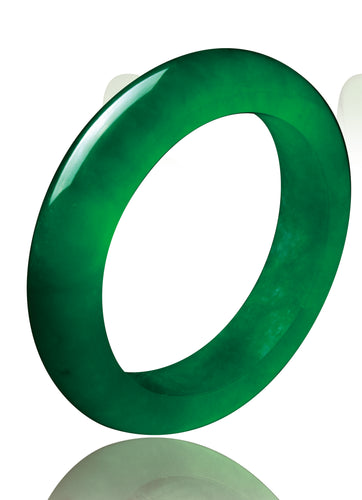
Jade Misnomers
Due to the high value of jade, many misnomer (meaning incorrect name) are used innocently or on purpose to associate a similar gemstone (usually of much lower value) with jade to mislead buyers. A few of the many jade misnomers are listed below:
- “African Jade” - a massive variety of green grossularite garnet found in the Transvaal Province of South Africa
- “Amazon Jade” - amazonite, a blue-green microcline feldspar
- “American Jade” - californite, a variety of vesuvianite
- “Bowenite Jade” - a variety of serpentine resembling nephrite
- “Garnet Jade” - a massive variety of green grossularite garnet
- “Honan Jade” - a name used for a variety of jade substitutes including jade in quartz, serpentine, soapstone
- “Mexican Jade” - green-dyed calcite or greenish travertine
- “Indian Jade” - aventurine quartz
- “Korean Jade” - a variety of jade look-alikes including glass, soapstone and serpentine
- “Manchurian Jade” - soapstone
- “Oregon Jade” - green jasper, green grossularite or other jade look-alikes found in Oregon
- “Serpentine Jade” - varieties of serpentine that look like jade
- “Soochow Jade” - name used for a variety of jade substitutes including jade in quartz, serpentine, soapstone
- “South African Jade” - green grossularite found in the Transvaal Province of South Africa
- “Transvaal Jade” - green grossularite found in the Transvaal Province of South Africa
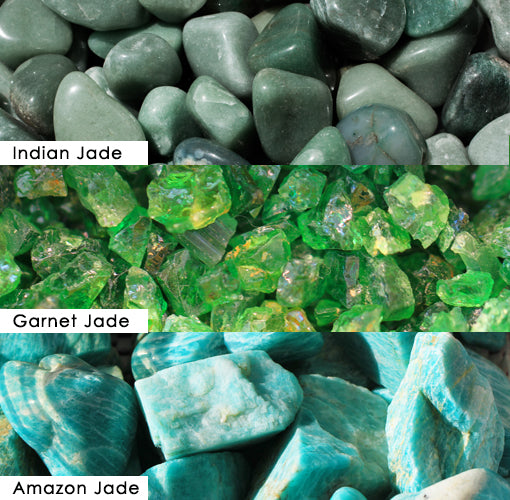
Jade Look-Alikes
There are also some minerals and materials that are commonly cut and polished to be easily confused with jade. Some examples that are commonly confused with jade include chalcedony, serpentine, vesuvianite, maw sit sit, Hydrogrossular garnet, aventurine, etc. It is important to know that these jade look-alikes, along with plastic and glass made into objects in the same style as jade, are abundant in the market place. Buying from a reputable retailer that you can trust is the key to avoid errors and deception.
Four gems commonly confused with jade are chrysoprase, maw sit sit, serpentine, and hydrogrossular garnet. They have a color, luster, and translucence that is known to occur in jade.
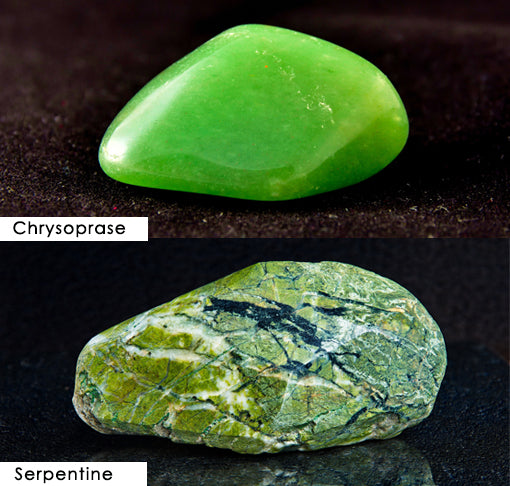
Lao Feng Xiang Jade
Lao Feng Xiang (LFX) has been in the jade business for over a decade. We directly buy from the top quality jadeite mines in Burma and have the best skilled expert craftsmen in China to maximize the most beauty of the stone. LFX sells only Type A jadeite and provides NGTC certificate for every piece of jadeite product we sell. Being the oldest and largest jewelry company in China, LFX is the one of the most trustworthy retailers to buy jade from. Customers are sure to be worry free and be proud of having a LFX jade that guarantee them the best value over time.
